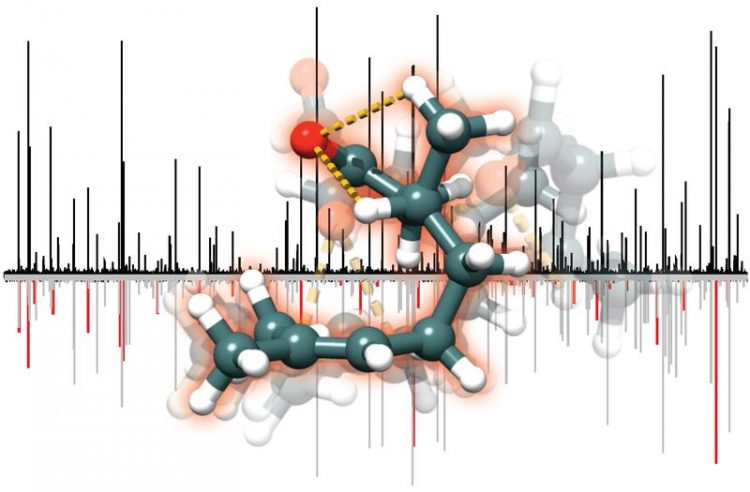Unexpected flexibility found in odorant molecules

Structure of the most stable globular form of citronellal. © S. R. Domingos / MPI for the Structure and Dynamics of Matter
In a recent publication in the journal Physical Chemistry Chemical Physics, researchers from the Max Planck Institute for the Structure and Dynamics of Matter at the Center for Free-Electron Laser Science and from the Hamburg Centre for Ultrafast Imaging (CUI) led by Melanie Schnell have unraveled the complex conformational landscape of an odorant biomolecule.
The science of the scent is shrouded in mystery. How our body interprets odor is still a subject of active debate worldwide. We do know however, that the functionality of a specific biomolecule is directly related to how the molecule “fits” in its target biological receptor, much like a key that only fits in a certain door lock. Many biochemical processes are governed by this so-called lock-and-key mechanism. The size, shape and flexibility of the key are what defines how good it binds to its target, i.e., can it or can it not open the right door?
To shed some light on these mechanisms, the researchers performed a high-resolution rotational spectroscopy study using citronellal, a versatile biochemical precursor that naturally appears in many plant oils. It has a distinct lemon scent and is often exploited in the cosmetics industry.
The researchers discovered that this molecule can adopt an impressive number of shapes simply by rotation around five single carbon-carbon chemical bonds. Those orchestrated rotations result in an extraordinarily large number of stable forms of the molecule.
A total of fifteen forms have been identified. “We show evidence that this incredibly flexible system has a preference for globular shapes, i.e., it likes to fold on itself,” says Sérgio Domingos, first author of this work. “This observation allowed us to derive important information concerning the possible interactions of this molecule with its biological receptors.”
The number of conformations (keys) observed for this molecule constitutes a world record for the microwave spectroscopy community. “The extraordinary shape-shifting ability of this odorant molecule provides particular insights on the relation between structure and function of a biomolecule. Not only we found fifteen keys, but we also know which ones might fit better in the door lock,” concludes group leader Melanie Schnell.
Contact persons:
Dr. Sérgio Domingos
Max Planck Institute for the Structure and Dynamics of Matter
Center for Free-Electron Laser Science
Luruper Chaussee 149
22761 Hamburg
Germany
+49 (0)40 8998-6233
sergio.domingos@mpsd.mpg.de
PD Dr. Melanie Schnell
Max Planck Institute for the Structure and Dynamics of Matter
Center for Free-Electron Laser Science
Luruper Chaussee 149
22761 Hamburg
Germany
+49 (0)40 8998-6240
melanie.schnell@mpsd.mpg.de
Original publication:
S. R. Domingos, C. Pérez, C. Medcraft, P. Pinacho, and M. Schnell, “Flexibility unleashed in acyclic monoterpenes: conformational space of citronellal revealed by broadband rotational spectroscopy,” Physical Chemistry Chemical Physics 18 (25), 16682-16689 (2016); DOI: 10.1039/C6CP02876D
Weitere Informationen:
http://dx.doi.org/10.1039/C6CP02876D Original publication
http://www.mpsd.mpg.de/en/research/irg/ccm Research group of PD Dr. Melanie Schnell
http://www.mpsd.mpg.de/en Max Planck Institute for the Structure and Dynamics of Matter
Media Contact
All latest news from the category: Life Sciences and Chemistry
Articles and reports from the Life Sciences and chemistry area deal with applied and basic research into modern biology, chemistry and human medicine.
Valuable information can be found on a range of life sciences fields including bacteriology, biochemistry, bionics, bioinformatics, biophysics, biotechnology, genetics, geobotany, human biology, marine biology, microbiology, molecular biology, cellular biology, zoology, bioinorganic chemistry, microchemistry and environmental chemistry.
Newest articles

Properties of new materials for microchips
… can now be measured well. Reseachers of Delft University of Technology demonstrated measuring performance properties of ultrathin silicon membranes. Making ever smaller and more powerful chips requires new ultrathin…

Floating solar’s potential
… to support sustainable development by addressing climate, water, and energy goals holistically. A new study published this week in Nature Energy raises the potential for floating solar photovoltaics (FPV)…

Skyrmions move at record speeds
… a step towards the computing of the future. An international research team led by scientists from the CNRS1 has discovered that the magnetic nanobubbles2 known as skyrmions can be…





















